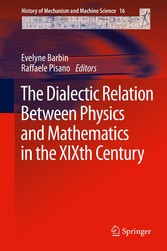Suchen und Finden
The Dialectic Relation Between Physics and Mathematics in the XIXth Century
The aim of this book is to analyse historical problems related to the use of mathematics in physics as well as to the use of physics in mathematics and to investigate Mathematical Physics as precisely the new discipline which is concerned with this dialectical link itself. So the main question is: When and why did the tension between mathematics and physics, explicitly practised at least since Galileo, evolve into such a new scientific theory?
The authors explain the various ways in which this science allowed an advanced mathematical modelling in physics on the one hand, and the invention of new mathematical ideas on the other hand. Of course this problem is related to the links between institutions, universities, schools for engineers, and industries, and so it has social implications as well.
The link by which physical ideas had influenced the world of mathematics was not new in the 19th century, but it came to a kind of maturity at that time. Recently, much historical research has been done into mathematics and physics and their relation in this period. The purpose of the Symposium and this book is to gather and re-evaluate the current thinking on this subject. It brings together contributions from leading experts in the field, and gives much-needed insight in the subject of mathematical physics from a historical point of view.
Evelyne Barbin (France, 1949), full professor of epistemology, history of science and technology at the University of Nantes. Her research concerns mainly: history of mathematics in 17th century (the emergence of infinitesimal calculus; relations between physics, technics and mathematics); the meaning of mathematical proof in history, research on mathematics and the sciences in the 19th century (the contrast between synthetic and analytic geometry; the heritage of Monge and Carnot in France; discourses on science and discourses on sciences in the 19th century), history of algorithms and machines, relations between history and teaching. She is author of about 100 papers and 20 edited books. Recent books: La révolution mathématique du XVIIe siècle, Paris: Ellipses, 2006; Sciences et arts visuels. Représentations du corps et matériaux de l'art (ed. E. Barbin, D. Le Nen,), Paris: Vuibert, 2009; 1867 L'année de tous les Rapports. Les lettres et les sciences à la fin du Second Empire (ed. E. Barbin, J.-L. Godet, G. Stenger), Pornic: Éditions du Temps, 2009; Gabriel Lamé. Les pérégrinations d'un ingénieur du XIXe siècle (ed. E. Barbin) Paris: Sabix, École Polytechnique, 2009. De grands défis mathématiques d'Euclide à Condorcet (ed. E. Barbin), Paris:Vuibert, 2010.
Raffaele Pisano (Italy, 1970), lauream in physics (University of Naples 'Federico II'), specialized in teaching both physics and mathematics (University of Naples 'Federico II'), and a Ph.D. (University of Rome 'La Sapienza'). He was temporary professor of history of physics at (SSIS, University of Udine) and since 2006 he is currently Member of steering committee of European Society for the History of Science. He recently edited: Scienze e Religioni. Il ruolo delle scienze naturali, ipotesi di studio e prospettive (Uniservice editore, 2008, with Rafael Pascual), Qual è il ruolo culturale ed interdisciplinare delle scienze fisiche e matematiche? Ipotesi e prospettive, (2010. Laveglia, Salerno); Da Archimede a Majorana: La fisica nel suo divenire. Atti del XXVI Congresso SISFA, (Guaraldi, 2009, with Giannetto E., Giannini G. and Capecchi D.). He published papers for international and national reviews on history of physics, mathematics and their historical foundations. Recent books: Scienza e tecnica nell'architettura del Rinascimento, (Cisu, 2010, with Danilo Capecchi). Lazare and Sadi Carnot. A scientific and Filial relationship, (Springer, 2012,with Charles C Gillispie).
Currently he is Research Fellow at Centre François Viète, Université de Nantes, France.
Alle Preise verstehen sich inklusive der gesetzlichen MwSt.







